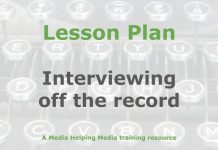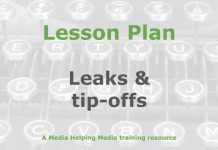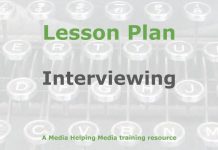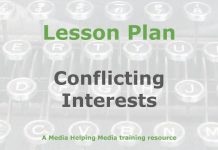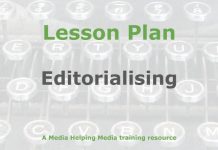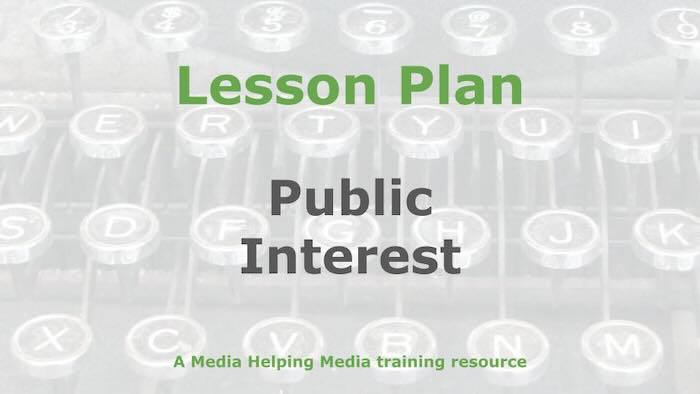 A lesson plan to help students understand the difference between ‘public interest’ journalism and news that merely entertains.
A lesson plan to help students understand the difference between ‘public interest’ journalism and news that merely entertains.
It’s based on the article Journalism and the public interest which is published on Media Helping Media. We recommend you read the article before adapting this lesson plan.
Learning objective
Students will evaluate the concept of “public interest” in journalism by distinguishing between news stories that serve the common good and those that merely entertain. They will analyse case studies to identify ethical considerations and justify decisions based on public interest.
- Student-facing objective: By the end of this lesson the student will be able to tell the difference between news that helps society and news that’s just little more than entertainment, and explain why some stories are important for everyone.
- Standards: To help students understand what “public interest” means in journalism.
Learning activities
Warm-up
Notice and wonder: Display a headline or brief excerpt from a news story. Ask students, “What do you notice? What do you wonder?” Give them a few minutes to think and discuss with a partner. Then, have several students share their observations and questions. Record these for all to see. Guide the conversation towards distinguishing between elements that serve the public interest and those that might simply entertain.
Direct instruction
- Define public interest: Begin by explaining the concept of “public interest” in journalism. Highlight its focus on societal relevance, the common good, and the distinction from mere entertainment. Use real-world examples, such as a news story about a public health issue versus celebrity gossip, to illustrate the difference. Encourage students to think critically about why certain stories are more impactful for society.
- Case study analysis: Present a case study involving a controversial news story. Describe the scenario, including key facts and ethical dilemmas. Ask students to identify elements that align with the public interest and those that do not. Facilitate a discussion on the ethical considerations journalists must weigh, such as privacy versus the public’s right to know. Use placeholders for where you will provide solution steps and guide students through the analysis.
- Public interest test: Introduce the concept of a “public interest test” that journalists use to decide whether to cover a story. Provide criteria such as correcting a significant wrong, enhancing public understanding, or promoting accountability. Present a hypothetical news scenario and have students apply the public interest test to determine if it should be reported. Discuss their reasoning and the potential impact on society.
Guided practice
Think, Pair, Share: Guide students through a structured discussion to deepen their understanding of public interest in journalism.
- Think: Present a news headline or brief excerpt. Ask students to individually consider whether the story serves the public interest or merely entertains. Encourage them to jot down their thoughts and reasoning.
- Pair: Have students pair up to discuss their individual assessments. Instruct them to compare their reasoning and identify any differences in their evaluations.
- Share: Invite pairs to share their conclusions with the class. Facilitate a discussion that highlights diverse perspectives and reasoning.
- Clarify: As a class, clarify any misconceptions about public interest. Use examples from the discussion to reinforce the distinction between public interest and entertainment.
- Reflect: Ask students to reflect on how their understanding of public interest has evolved through the activity. Encourage them to consider how this understanding might influence their consumption of news.
Independent practice
- Case study evaluation: Provide students with a new case study involving a news story. Ask them to independently evaluate whether the story serves the public interest or merely entertains. Instruct them to apply the public interest test criteria discussed earlier.
- Written justification: Have students write a brief justification for their evaluation, citing specific elements of the story that align with or diverge from the public interest. Encourage them to consider ethical considerations and potential societal impacts.
- Peer review: Pair students to exchange their written justifications. Instruct them to review each other’s work, providing constructive feedback on the clarity and strength of the arguments presented.
- Reflection: Ask students to reflect on the feedback received and consider any revisions to their initial evaluation. Encourage them to think about how this exercise might influence their future news consumption and understanding of journalism’s role in society.
Assignment
Ask students to answer these questions:
- How can you tell if a news story serves the public interest?
- Why is it important for journalists to consider the public interest when reporting?
- What’s one question you still have from today’s lesson?
Here are some suggested answers:
- Suggested answer to Question 1: A news story serves the public interest if it addresses issues affecting public well-being, safety, or accountability.
- Suggested answer to Question 2: Considering the public interest ensures that journalism contributes to a well-informed society and holds power accountable.
Teacher resources
Differentiation guide
- Advanced learners: Encourage deeper analysis by having students explore complex case studies involving ethical dilemmas in journalism. Challenge them to debate the nuances of public interest versus privacy, especially in cases involving public figures. Suggest they research historical examples where journalism significantly impacted society, and present their findings to the class.
- Striving learners: Simplify case studies and provide clear, structured examples of public interest versus entertainment. Use visual aids and graphic organisers to help them categorise news stories. Pair them with peers for collaborative analysis and provide sentence starters to support their written justifications. Offer additional guidance during discussions to ensure comprehension.
- Background reading: We recommend you read the article Journalism and the public interest before adapting this lesson plan.
Notable definitions
- Public interest: The welfare or well-being of the general public; a concept in journalism that focuses on reporting news that affects society’s health, safety, and governance, rather than what merely entertains.
- Ethical considerations: The moral principles that guide journalists in deciding whether a story serves the public interest, including issues of privacy, accountability, and transparency.
- Public interest test: A set of criteria used by journalists to determine if a news story should be reported, based on its potential to correct wrongs, enhance public understanding, or promote accountability.
Required materials
- News articles or excerpts for analysis
- Case study materials
- Whiteboard and markers
- Paper and pens for student notes
- Copies of the public interest test criteria
- Access to computers or tablets (optional, for research)
Lesson summary
- Warm-up
- Direct instruction
- Guided practice
- Independent practice
- Assignment
The free teaching tools at the Khan Academy were used in the production of this lesson plan.
Related article


